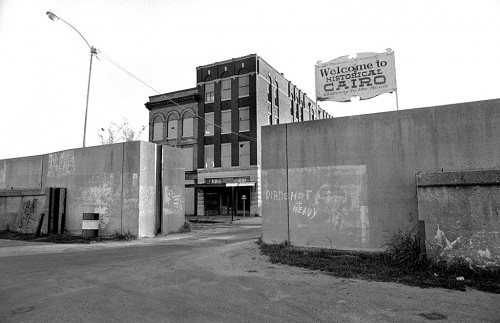 Cairo is a town of subtraction. I still take visitors there, but there is less and less to show them. It’s gotten so I hardly pull the camera out because there’s nothing but open ground where a vibrant downtown once flourished.
Cairo is a town of subtraction. I still take visitors there, but there is less and less to show them. It’s gotten so I hardly pull the camera out because there’s nothing but open ground where a vibrant downtown once flourished.
Here’s a view through a floodgate opening at 8th Street in some time around 1967. You can click on the photos to make them larger.
Looks pretty much the same in 2010
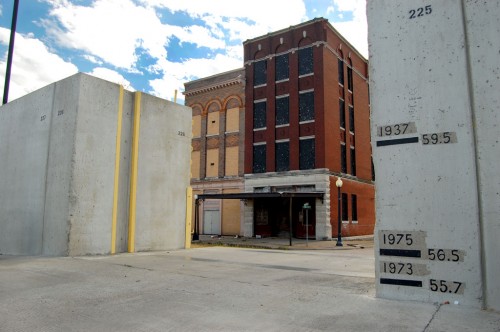 Except for being in color, the two photos are pretty much the same. This one was taken October 26, 2010.
Except for being in color, the two photos are pretty much the same. This one was taken October 26, 2010.
2012 fire erases old buildings
A fire started in an adjacent building and quickly spread to these two old warehouse buildings. This was taken November 13, 2012.
Nothing left but pile of bricks
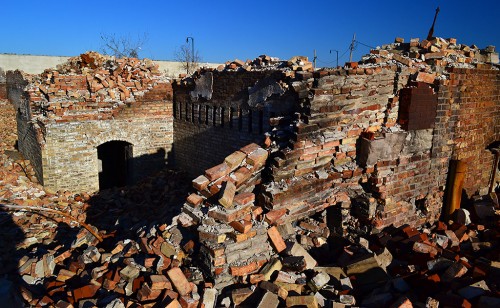 When the fire was over, nothing much was left except a pile of bricks and some columns.
When the fire was over, nothing much was left except a pile of bricks and some columns.
Not even the bricks remain
By July 10, 2013, you would never know the buildings existed.
A line has been added to show the 2011 record 61.7-foot highwater mark on the floodwall. There is a common misconception that the Bird’s Point Levee was blown just to save Cairo. In fact, it reduced pressure on the levees and floodwalls in Brookport, IL, Paducah, KY, Cairo, IL, Hickman KY and Tiptonville, TN. Some have speculated that Olive Branch might not have flooded if the levee had been breached earlier.
The reason Cairo got so much attention was that the Cairo river gauge was the one used to judge when it was time to activate the floodway that had been in place since 1937.
Older Cairo stories
I’ve photographed Cairo since the 1960s. Here are some older stories and photos.
- Barry Goldwater campaigning at the high school
- An overview of Cairo
- The Delta Queen visits Cairo
- The City of Cairo, Illinois, caboose
- 43 years of Cairo photographs
- Video crew visits Cairo

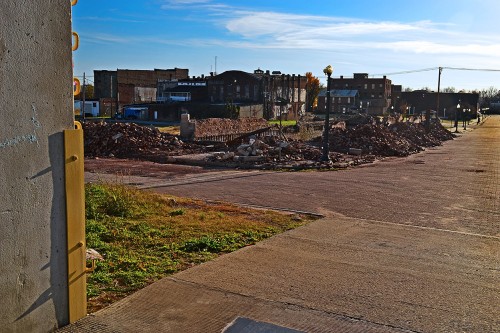
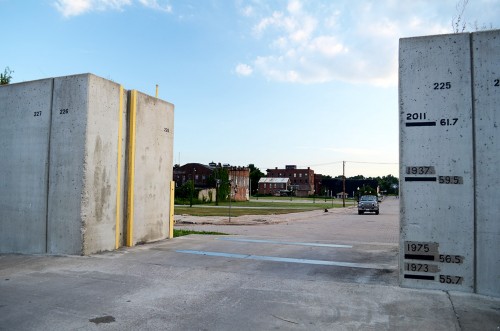
Cairo should be at the top of everyone’s places to visit in America; the hidden America that still quietly festers, that just can’t seem to completely heal.
Thanks for taking us there Ken. We slept in the motorhome there the night we left your mother’s. It was quiet, almost too quiet.
Where did you park? Ft. Defiance?
Go into any of the towns around Cairo such as Charleston, Wycliff, Mounds or Olive Branch and you see gas stations and places to eat. Nothing in Cairo invites you to stop and spend. Even THE place to visit there, Fort Defiance Park, is poorly kept. Cairo became a community of victims instead of proud citizens. Takers and users instead of builders, maintainers and entrepreneurs. In my opinion, but for Highway 3 as it’s main street, there would be little need for the town. Even the Dollar Store built outside of the city limits. Now that organized crime has left the area, there seems to be no leadership.
The reasons for Cairo’s demise are many, but the small print under the sign in the first photo will give you one clue. It says, “Welcome to Historical Cairo – Gateway to the South.”
Stace England, who has produced a CD of music that tells the history of the town better than anything I’ve read, has a song, “The North Starts in Cairo,” where he says that buses coming from the South segregated blacks and whites with a curtain “until we cross the Ohio and that curtain’s comin’ down.”
So, while the rest of the country thought of Cairo as the gateway to the North, the city was still looking to its Southern roots.
It was a town that cut off its nose to spite its face. When blacks wanted to swim in the city pool, the city first tried to make it private; when that didn’t work, they filled it in rather than integrate it.
White merchants would sell to blacks, but they wouldn’t hire them to work in the stores. When the blacks organized a boycott, the merchants closed their doors. Eventually, after a 19-year-old black soldier who “committed suicide” in jail, race relations deteriorated into rioting, burning and looting. That was the beginning of the end.
Another factor was the construction of the railroad bridge at Thebes in 1905, which shifted rail traffic away from Cairo.
You might quibble with some details of my memory, but the demise wasn’t as simple as dismissing those who lived in the town as “takers and users.”
Here is an excellent link to an overview of the history of Cairo.
Ken, thank you for taking the time to clear up the misconceptions. Also, young people in small towns across the US are still migrating to more urban areas seeking employment opportunities.
Cairo is is place that time just moved away from. The spirit of the town died and the only ones left those who could not leave or were just stuck there. It is sad, but there is somewhere, someone who is just beginning to get an idea, “Hey I need a new place to live, start a business and raise a family”. He or she probably does not know but Cairo is the place. When this happens then Cairo will come back.
Ken
As a person that grew up in Cairo for 9 years and graduated from Central in 71, I would like to suggest that unless you actually lived in Cairo and experienced the the demise of a really great small town with many truly great people, you only have a smattering of an understanding why Cairo looks the way it looks.
Look at Detroit…scale it down….you have Cairo….it is that simple.
David Zimmer
Enlighten us, then.
It’s a shame Cairo went so downhill. I lived in Cairo in 1960 and in Mounds in the 1950`s. I continue to go through Cario every few years on my travels; and unfortunately, it is still going down hill. Perhaps one day it will rise again.